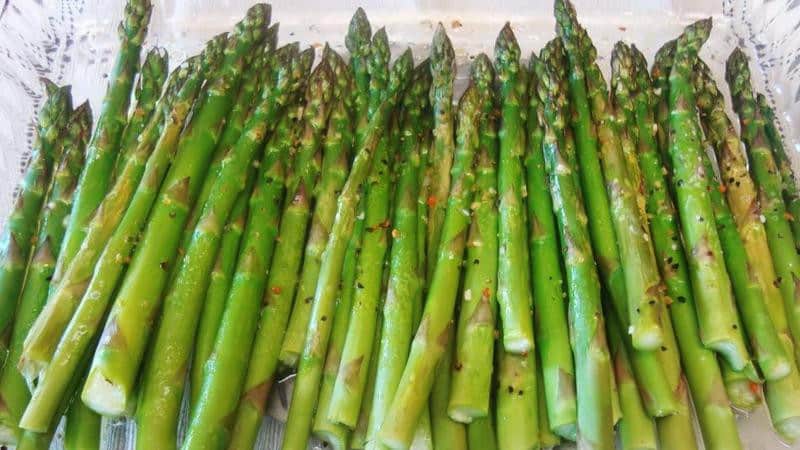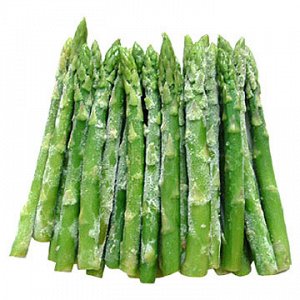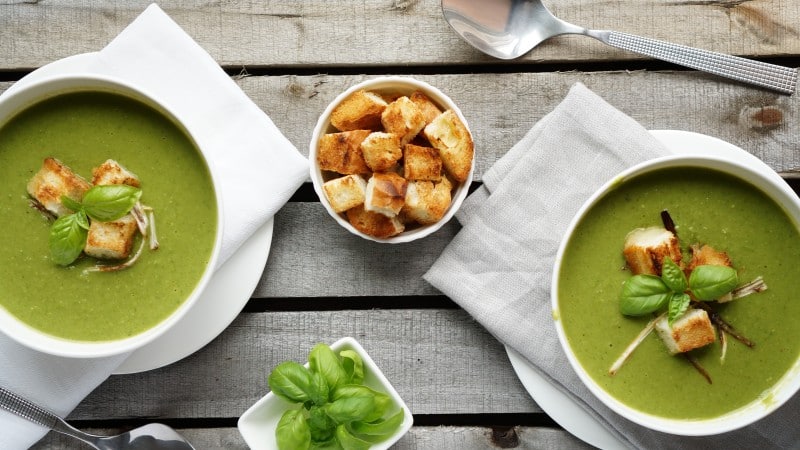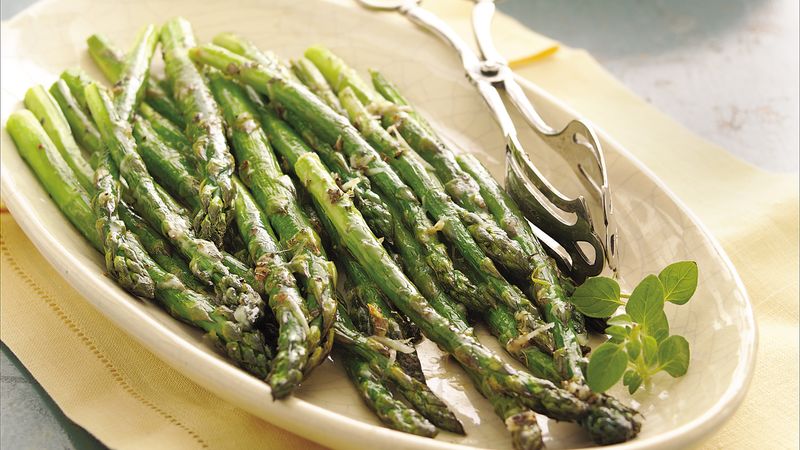What is good about frozen asparagus and how to cook it correctly
Asparagus plants are distributed throughout the world. The most popular edible species include asparagus officinalis (another name is asparagus).
In ancient times, many miraculous properties were attributed to this healthy and tasty delicacy, including a beneficial effect on male potency. Due to its effectiveness in this regard, the plant was even forbidden to be used by monks. Later, doctors proved the positive effect of this plant on the body.
Is it possible to freeze asparagus
You can and should freeze asparagus. Of course, fresh vegetables straight from the garden are the most healthy and tasty. However, their disadvantage is that they do not last long. To treat yourself to dishes with asparagus in the fall and winter, it is frozen.
 When frozen, the vegetable retains all its beneficial properties, color and shape. But the characteristic crunch will not remain after defrosting. These days, frozen vegetables are sold year-round, but homemade ones will cost you significantly less.
When frozen, the vegetable retains all its beneficial properties, color and shape. But the characteristic crunch will not remain after defrosting. These days, frozen vegetables are sold year-round, but homemade ones will cost you significantly less.
What's good about frozen asparagus?
100 g of product contains:
- proteins - 3.2 g
- fats - 0.2 g
- carbohydrates 4.1 g
- water - 91.82 g,
- ash - 0.62 g.
- vitamins A, C, B1, B2, B3 (PP), B5, B6 and B9.
Asparagus has a lot of potassium - 253 mg per 100 g of product. This element improves the functioning of the cardiovascular system, muscles, brain, liver and kidneys. Phosphorus content - 64.0 mg, calcium - 25.0 mg, magnesium - 14.0 mg.
Phosphorus is necessary for all tissues and cells of the body, and its main function is the formation of teeth and bones and participation in cellular metabolism.Calcium performs the same tasks and additionally affects blood clotting. Magnesium is necessary for the absorption of calcium, stabilization of heart rate, and activation of metabolic processes. In addition to these minerals, asparagus contains iron, sodium, zinc, copper, manganese and selenium.
The calorie content of the product is 24 kcal.
The presence of vitamins and minerals necessary for humans makes this plant a valuable product. Asparagus cleanses the liver, strengthens the heart muscle, lowers cholesterol levels in the blood, and improves immunity. Fiber has a beneficial effect on intestinal function.
Attention. It is not recommended to eat asparagus if you have inflammation of the stomach and intestines. Saponins in the plant can aggravate the inflammatory process.
How to properly freeze asparagus for the winter
It is recommended to freeze a plant picked from the garden or purchased as soon as possible, before it loses useful properties. Ice cubes are frozen in advance. The required amount of fresh, firm asparagus is washed with water, paying attention to each stem. The base is cleaned with a knife or vegetable peeler. The wilted stems are set aside separately. After freezing, they will be too soft and suitable only for puree soup or cream.

Boil water in one pan, add cold water to another. The stems are blanched in boiling water for 2 minutes, at which time ice is added to cold water and after the specified boiling time, the asparagus is transferred to water with ice.
These 2 steps are required before freezing. Without blanching, it will turn black in the freezer and lose its taste. And without immediate sharp cooling in ice water, it can be overcooked and will not retain its green color. After cooling, the stems are laid out on a clean towel with a small distance from each other so that the asparagus dries well.
Freezing methods depend on how you intend to use the product:
- whole stalks are frozen for baked and fried asparagus;
- short or chopped stems - for stews and salads;
- The slightly wilted stems are blanched and cooled separately from the rest, then cut into small pieces and frozen. In this form they are suitable for puree soups, creams and sauces.
Terms and conditions of storage
The stems are placed in an even layer in a bag, tightly closed and placed on the bottom of the freezer or on the bottom of a drawer in the freezer, as they will break easily on an uneven surface.
Attention! Frozen asparagus can be stored at temperatures ranging from -18 °C for up to 10 months.
How to defrost correctly
Before cooking, asparagus does not need to be thawed first, otherwise it will lose all its beneficial properties. Before freezing, it has already been briefly treated with boiling water, so it can be cooked immediately, without defrosting.
How to use frozen asparagus

Frozen stems are boiled, fried and baked. Let's look at the most delicious recipes.
Cream soup with asparagus
Ingredients:
- 250 g asparagus;
- 2 tbsp. butter;
- 50 ml cream 35%;
- 2 tbsp. l. flour;
- ½ lemon;
- 1 tsp. salt;
- spices to taste;
- 1 liter of water.
Preparation:
Add frozen pieces of asparagus to boiling water and cook for 15 minutes; fry the flour in butter in a frying pan until golden brown. Half a glass of broth from the pan is gradually added to the flour, stirring until smooth. Remove the pan from the heat and after 5 minutes puree the soup with a blender. Put it back on the fire, add the flour mixture, cream and heat for one minute so that the cream does not curdle, then add lemon juice and remove from the heat. The soup can be sprinkled with finely chopped herbs and served with garlic croutons.
Important! The fat content of the cream should be at least 35%, otherwise it will curdle after contact with lemon juice.
Roasted Asparagus with Hollandaise Sauce

Ingredients:
- 400 g asparagus;
- salt to taste;
- butter.
For the sauce:
- 250 g butter with 82% fat content;
- 3 egg yolks;
- 1 tbsp. l. lemon juice;
- salt, white pepper.
Preparation:
Each stem, without defrosting, is greased with melted butter, placed on parchment paper on a baking sheet, and sprinkled with salt. The stems should lie at a short distance from each other. Place the baking sheet in an oven preheated to 205°C and bake the vegetables for 20 minutes. To ensure the asparagus is slightly crispy, bake it for no more than 12 minutes.
For the sauce, melt the butter. Place the yolks in a heatproof bowl, beat until smooth, add lemon juice, salt and pepper. Without ceasing to stir, gradually add melted butter and 2 tbsp to the yolks. l. hot water. Place the bowl in a water bath and, stirring constantly, let the sauce sit for 10-15 minutes until thickened. The asparagus is placed on a plate and served with sauce in a gravy boat.
Read also:
What is soy asparagus, how is it useful and how to use it correctly.
What are the benefits of pickled asparagus and how to cook it at home.
In what form and how to properly freeze green beans at home.
Asparagus with almonds

Ingredients:
- asparagus 1 kg;
- almonds 30 g;
- butter 15 g;
- salt, pepper to taste.
Preparation:
Almonds are lightly crushed with a blender and fried in a frying pan with butter and hot pepper. Add asparagus straight from the freezer and cook for 10 minutes, stirring gently.At the end of cooking, add heat to evaporate excess liquid and place on plates. Serve as a separate dish or as a side dish for meat, fish or poultry.
Attention! After turning up the heat, be careful not to burn the dish.
Conclusion
Frozen asparagus is an opportunity to prepare a healthy dish in 15 minutes and a healthy and tasty product. When properly frozen in two stages, the plant retains its beneficial properties and appearance. Asparagus is served as an independent dietary dish or as a side dish.